
Summary
Multigrain bread is a type of bread prepared with two or more types of grain.[1] Grains used include barley, flax, millet, oats, wheat, and whole-wheat flour,[2][3] among others. Some varieties include edible seeds in their preparation,[4] such as flaxseed, quinoa, pumpkin seeds, and sunflower seeds.[3][5] Rye and sourdough multigrain breads are additional varieties.[4][6][7] Preparations include 7-grain and 9-grain bread,[8] among others.


Multigrain bread may be prepared using whole, unprocessed grains,[9] although commercial varieties do not necessarily always contain whole grains.[1]
Nutritional content edit
Whole grain multigrain breads contain a dietary fibre content of up to four times greater than white breads[4][10] and may also contain more vitamins and protein compared to white bread.[11] Multigrain breads also provide complex carbohydrates.[12]
Commercial varieties edit
Multigrain bread is commercially mass-produced and marketed to consumers.[13] Some commercial varieties are prepared using 100% whole grain flour.[13] Between 1989 and 1994 in the United States, multigrain bread was "one of the fastest growing markets within the bakery sector".[14]
Use in brewing edit
A 4,000-year-old Mesopotamian recipe for brewing beer from multigrain loaves of bread mixed with honey is the oldest surviving beer recipe in the world.[15] The Brussels Beer Project microbrewery in Belgium has developed an amber beer with a 7% alcohol by volume named Babylone that incorporates this recipe using leftover, unsold fresh bread donated by supermarkets.[15][16][17]
See also edit
References edit
- ^ a b Kirkpatrick, Kristin (February 20, 2014). "6 Ways the Food Industry Is Tricking You". U.S. News & World Report. Retrieved May 1, 2015.
- ^ Media, Demand (April 29, 2015). "Rye Bread Vs. Multigrain Bread". SFGate.com. Retrieved May 1, 2015.
- ^ a b Katzin, C.F. (2010). The Everything Cancer-Fighting Cookbook. Everything. F+W Media. p. 246. ISBN 978-1-4405-0747-2.
- ^ a b c NewsLifeMedia (April 30, 2015). "News". Taste.com.au. Retrieved May 1, 2015.
- ^ "What's the best bread for your family?". News.com.au. May 1, 2015. Retrieved May 1, 2015.
- ^ Reinhart, P. (2011). Crust and Crumb: Master Formulas for Serious Bread Bakers. Potter/TenSpeed/Harmony. p. 278. ISBN 978-1-60774-132-9.
- ^ Suas, M. (2008). Advanced Bread and Pastry. Cengage Learning. p. 227. ISBN 978-1-4180-1169-7.
- ^ Decker, J.; Neuhaus, E. (2005). The World's Fittest You. Penguin Group US. ISBN 978-1-101-21999-7.
- ^ Harrington, Theresa (November 30, 2012). "Mt. Diablo school district cooks up a tasty multigrain bread". San Jose Mercury News. Retrieved May 1, 2015.
- ^ Wilkins, L.W. (2007). Nutrition Made Incredibly Easy. Incredibly easy. Lippincott Williams & Wilkins. p. 256. ISBN 978-1-58255-521-8.
- ^ Gupta, P.; Gupta, D. (2013). Losing It! Making Weight Loss Simple. Pan Macmillan. ISBN 978-1-4472-4244-4.
- ^ Evans, J.; Aronson, R. (2005). The Whole Pregnancy Handbook: An Obstetrician's Guide to Integrating Conventional and Alternative Medicine Bef ore, During, and After Pregnancy. Penguin Publishing Group. p. 224. ISBN 978-1-4406-2342-4.
- ^ a b "Bimbo To Buy Canada Bread From Maple Leaf For $1.66 Billion". Getty Images. February 12, 2014. Retrieved May 1, 2015.
- ^ "Food Processing". Volume 63. Techpress (FPI) Limited. 1994. p. 36. Retrieved 30 April 2015.
- ^ a b Bartunek, Robert-Jan (April 17, 2015). "Brussels brewer uses leftover bread to make beer". Reuters. Retrieved May 1, 2015.
- ^ Szal, Andy (April 23, 2015). "Belgian Brewery Turns Food Waste Into Beer". Manufacturing.net. Retrieved May 1, 2015.
- ^ "Babylone - from bread to beer". Beer Project Brussels. April 20, 2015. Retrieved May 1, 2015.
Further reading edit
- Indrani, D.; et al. (June 2010). "Multigrain bread–its dough rheology, microstructure, quality and nutritional characteristics". Journal of Texture Studies. 41 (3): 302–319. doi:10.1111/j.1745-4603.2010.00230.x. (subscription required)
- Henriques, A.S. (2000). The Effects of Gum Incorporation on the Staling Properties of Multigrain Bread. University of Georgia. 316 pages.
External links edit
- Media related to Multigrain breads at Wikimedia Commons


